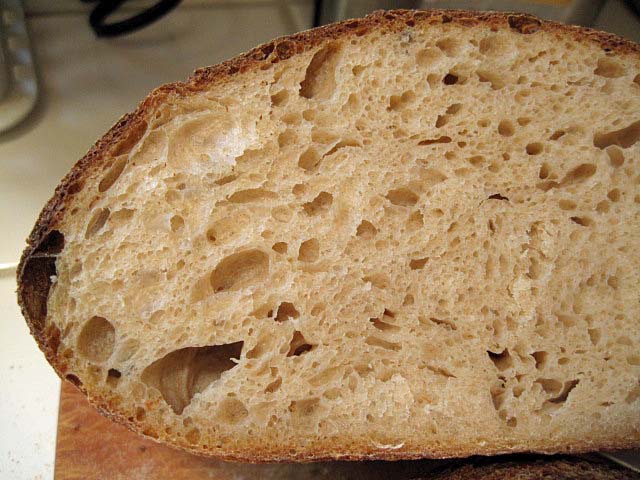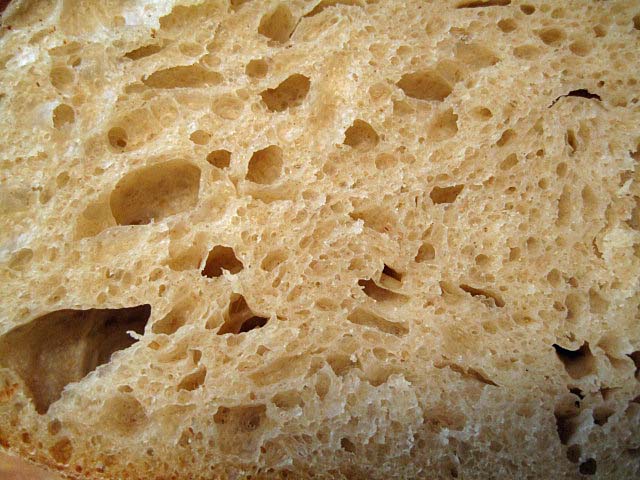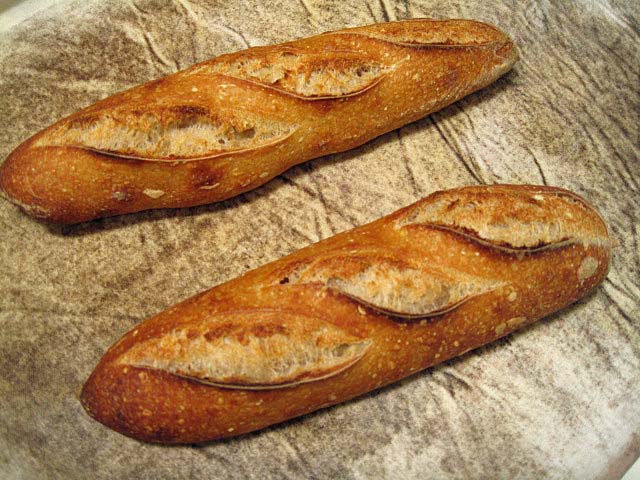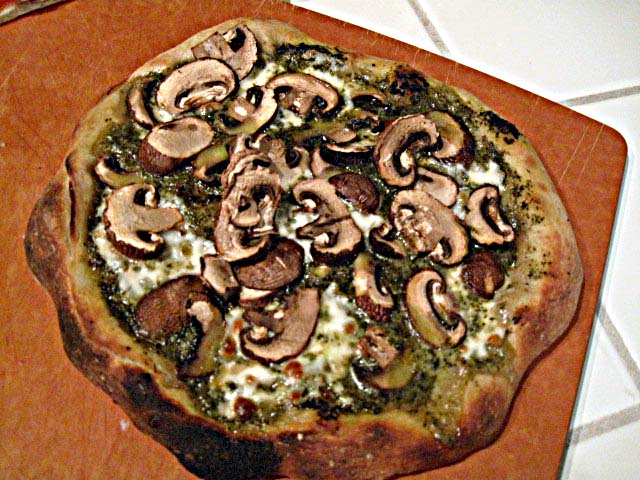
Pâte Pluripotente
Yeah. French makes everything seem fancier. Anyway, today I made three kinds of bread from the San Francisco-style Sourdough dough I've been playing with for the past couple months.
The dough was basically version 6. I put my stock starter through 3 builds of 75% AP and 25% WW at 50% hydration. The builds were fed at approximately 12 hour intervals, and the third build was cold retarded for about 14 hours then fermented at 85 dF for 3 hours before mixing the dough to make 2 kg. After dividing and shaping, all products were cold retarded again before final proofing and baking.

Boule made with 1 kg of SF-style SD dough

Boule crumb

Boule crumb close-up

Mini-baguettes made with 250 g of SF-style SD dough each.

Baguette crumb
These breads had a very crunchy crust and a complex, moderately sour flavor. The flavor was more like the version 4 bake than the last version 6 bake. It had a distinct milky, lactic acid element as well as the sharper acetic acid tang. Very, very yummy. I am happy that this formula and method are delivering consistant results for me.
The remaining 500 g of dough was divided into two pieces, shaped into balls and put in Ziploc sandwich bags along with a tablespoon of olive oil, then refrigerated for 24 hours.

Mozzarella, tomato, mushroom pizza

Pesto, mozzarella, mushroom pizza

Pesto, mozzarella, mushroom pizza close-up
The pizza was fair. The crust was chewy. My wife liked the flavor of the crust. I prefer a really thin, cracker-crisp crust. However, it's nice to know this dough makes fair pizza crust. If you like chewy rather than crisp, this may be for you.
Happy baking!
David


Comments
I love the rustic dark crust on that bread, David, and the crumb looks perfect. The pizzas aren't too shabby either!
Beautiful, as always.
Janie
David
My naming conventions are going viral.
Glad you named it and not me, which would have resulted in Pains Beaucoup de Saint-François au Levain. (Almost worse than the Italian one from Sunday, which was thankfully ignored by most).
-
Is version 6 the best one so far? I'm going to bake it or Greenstein's rye this week. (And hope I don't reproduce my faulty Larraburra loaf.)
http://www.thefreshloaf.com/node/28377/my-san-francisco-sourdough-quest-take-6-and-final
Versions 4 and 6 give about the same result. You can make minor time adjustments without a tremendous impact. Here is what I think the key steps are:
1. Regardless of how you keep your stock starter, do 2 feeds (or more) at 12 hour intervals, then mix the levain that goes into the final dough.
2. The first 3 feedings can be fermented at 70-76 dF. Ferment them pretty fully. They should triple in volume and be well aerated. Your times may vary from minor. You can build up from a small 1st feeding to the amount of levain you need.
3. Cold retard the levain (3rd feeding) for 12-16 hours then ferment for 2-3 hours, ideally at 85 dF, before mixing the final dough. Again, your time may vary. You don't want the levain to get to the point it collapses, but it may get a bit looser and sticky.
4. After bulk fermentation, dividing and shaping, proof the loaves for 1-2 hours at room temperature, then retard them for 12-16 hours.
5. Proof the loaves, ideally at 85 dF, until ready to bake
The rest of the procedure is as documented. Let me know how it turns out for you.
Happy baking!
David
Thanks, David.
I think I understand, but I want to make sure I'm not adding a build, as it looks like a 5-day process. (I also wonder if I should wait until I get a Brod & Taylor proofer, as the temperature ranges are precise, but that's another issue).
Here's the process (for version 6) as I follow it from your instructions (I'll leave out the dough procedures, as they're perfectly clear):
DAY 1
Remove MOTHER from refrigerator.
8 am. Create STOCK STARTER as:
8 pm. Feed STOCK STARTER again as:
DAY 2
8 am. Create ACTIVATED STARTER as:
12 midnight. Create INTERMEDIATE STARTER as:
DAY 3
12 noon. Build STIFF LEVAIN as:
6 pm. Refrigerate STIFF LEVAIN for 14 hours.
DAY 4
8 am. Remove STIFF LEVAIN from refrigerator and ferment at 85ºF for 3 hours.
11 am. Build FINAL DOUGH as:
3 pm. Shape and proof at 68-70ºF for 2-3 hours.
6 pm. Retard for 12 to 14 hours.
DAY 5
8 am. Proof loaves at 85º F for 3 hours in moist environment.
11 am. Bake 30 @ 460 F.
11:30 am. Oven off. With oven door ajar, bake 15 more minutes for a total of 45 minutes.
Thanks again,
Thomas
Well, I don't count the time to feed the stock starter. Typically, I've fed it a week or two weeks before. So ...
My own timeline would be more like this:
Day 1
8-9 AM - Activate Starter
8-9 PM - Feed Starter (intermediate build)
Day 2
9-10 AM - Mix levain
Whenever the levain looks pretty ripe but before it looks too ripe, refrigerate it. Might be about 4 pm.
Day 3
10 AM - Do the dough. (Autolyse. Add salt and levain. Mix. Ferment.)
6 PM (more or less) - Divide and shape. Proof partly.
9 pm (more or less) - Retard loaves.
Day 4
10, 11 AM or Noon - Take loaves out of fridge. Finish proofing for 2-3 hours.
Mid-afternoon - Bake
Dinnertime - Slice and enjoy.
About the time you should be going to bed - Blog.
For me, "Day 1" is typically Thursday. If I'm really organized (very hypothetical), I'd start Wednesday. This works with my schedule. I do not generally go into the office on Fridays. On my "home" days, I don't start working on breads until I've had a couple double-shot cappuccinos. On Saturday, I generally mix the autolyse before going to the famers' market and doing grocery shopping. Then I mix the dough. That's the main reason for my long autolyse.
I hope this clarifies (and is correct).
David
I guess I added that extra day.
I wasn't sure if it was necessary, but when I saw you were feeding it a mixture of flours (I just use bread flour), I decided to match it as much as possible.
Maybe I'll just cut it, because I know my mother is plenty strong enough to just jump to the ACTIVATED STARTER page. If I feed it your mixture of bread/ww/rye, it might take over the kitchen.
-
The use of only parts of previous builds in successor builds does pose a dilemma for the BBGA format. I haven't thought about how to represent something like that. I suppose the build quantities could be adjusted such that the weight of each predecessor build is fully used in the successor build, like all of the STOCK in the ACTIVATED and then all of the ACTIVATED in the LEVAIN. The math has to add up, so not using all of the each would break things.
I started Day 1 today (your Day 0).
1st feeding 50 g mother/stock, 100 g water, 200 g flour mix.
That's one firm starter.
Do you really keep your stock starter at such low hydration (50%)? Or did I err?
Yes. That is the formula recommended by Frank Sally for a starter that is going to be kept in the fridge between weekend bakes. The additional recommendations pertaining to this are:
1. Keep at least 350 g and ideally >400 g of stock starter. The SFBI feels this large bulk yields better flavor.
2. Before mixing a dough, feed the levain at least twice at 12 hour intervals.
I've been keeping the larger amount of starter for more than a year now, although I still use a different flour mix than SFBI recommends. I can't swear that this has improved my breads' flavor. However, keeping the stock starter this way sure keeps the beasties happy and ready to go to work when warmed up and fed.
In recent weeks, I have been more conscientious about feeding the starter twice before mixing the levain, and I am totally convinced the resulting flavor of the breads has improved. Cause and effect? I can't say, honestly, because I've changed other variables as well, notably length of fermentation and fermentation temperature, flour mix.
BTW, regarding the discussion in another topic about ideal starter ripeness, I am convinced that this is a variable the baker can manipulate according to the desired flavor profile. I first got thinking about this after reading what Chad Robertson had to say on the topic in Tartine Bread.
As we all know (or will learn eventually), when making bread, "everything matters."
David
Good to know. Thanks, David.
I was worried I was on the wrong track before leaving the starting gate.
I'll see what my mother can do with such a stiff starter over 12 hours. Nothing much after 4 hours @ 76 F, but it usually takes a while to get going.
I keep at least 2 cups of starter at all time. I know some get away with 1/2 cup, but I too find that greater starter volume = better-flavoured breads.
Note to self. Buy Tartine. You already own every other bread book ever published, why not this one?
The stiff starter has easily doubled (and it's still 5.5 hours from feeding).
So much for the worry.
That levain is a beast.
Made it less than two hours ago and it's already doubled.
It smells like an apple. :)
It must be really upset at this point. Kneaded into submission, fermented for 6 hours at 76 F, refrigerated for 14 hours at 44 F, now roasting at 85 F for 3.
I almost feel sorry for it.
David,
Is it possible that there are one too many fermentation periods in the documentation?
I had to cut 2. down to 1 hour. (It was 70 F and was still going like gangbusters)
After the overnight retard, I'm pretty sure I won't be able to proof for even 1 hour, less 3 hours @ 85 F.
I guess it just seems like a lot, even for a sourdough, and am wondering if there might be one too many bulk ferments/proofs in the docs.
I don't know where the "docs" you reference are. I can't find anything like what you cite in this topic.
David
Sorry for the lack of context.
I meant in your directions (not docs) for #6, after forming the final dough, it calls for:
- Ferment at 76ºF for 3.5 to 4 hours; stretch-and-folds at 50 and 100 minutes.
- Shape and proof at 68-70ºF for 2-3 hours.
- Retard for 12 to 14 hours.
- Proof loaves at 85º F for 3 hours in moist environment.
Is that one too many proofs? Could it be a typo/error in your directions?
I only ask because I won't get anywhere near those times without overproofing the loaf twice over.
I'll still get a nice couple of loaves out of this, but they'll be at least negative 4 hours on the proofing (the 3 hours at 85 is out because the loaves are fully proofed in the retarder). In short, the experiment won't be able to say anything with regards to reproducing #6 other than that I got close, but proofing times "went off the rails" at the end. That's a bummer, because the whole point was to try and reproduce your results.
...
I re-read your comment above (here: http://www.thefreshloaf.com/node/28489/p%C3%A2te-pluripotente#comment-214940)
What you say in that comment is more like what I'm experiencing:
I proofed for 1 hour after shaping and quickly put them in the refrigerator because they were proofing very fast.
When I remove them from the refrigerator tomorrow, I might get a 1-hour proof at 85 F, but that would be pushing it. I should probably bake them right out of the fridge.
Anyways, sorry to bother.
I've just been following the instructions on the original #6 (to the letter!) and was unnerved by the long proof times mentioned there.
The directions are an accurate description of what I did.
Several folks have found that their proofing goes faster than mine. I've given this some thought. One possibility is others' starter is just more active than mine. Now, my starter is pretty darn healthy, so, while this may be true in part, I have trouble believing that's the whole story. The other thought I have is that, when I form the loaves, I realy tighten the gluten sheath vigorously. This degasses the dough somewhat and also creates more resistance to expansion. This may be a major factor in my longer proofing times.
I think this is a good thing, if you want more time for acetic acid production.
David
I finished the bake about an hour ago.
The breads are beautiful. They have a wonderful, slightly acidic smell. The flavour, though, is just garden-variety Pain au levain.
I don't know how they would compare to a San Francisco sourdough, so can't really say (and I won't try to compare them to the San Francisco sourdoughs I've had outside of San Francisco, which were almost certainly 'doped' with acids of this or that variety).
I'm not disappointed, really, but I wonder if I'd managed to ferment it as long as you did if I would have achieved something more satisfying.
-
After I shaped the dough, I couldn't help but notice how similar it was to Nancy Silverton's sourdoughs, except hers are done in 2 days instead of 5.
She skips the multi-build process, going with a large volume of 80-100% starter on Day 1 with an overnight retard after bulk fermentation. Her bread's done on Day 2 and it's as good (if not better) than every other Pain au levain I've made with a multi-build process.
-
It kept me busy, though.
It also introduced me to stiff starters, something I've been meaning to learn/work with for a while.
So thank you, both for the recipe and for answering my silly questions along the way.
SFSD boule, baggies and pizza all in one shot should not be fair - but, am sure glad it is. What great crust and crumb once again. Just love dark, think crusts.
Nice bakes David.
David
It must be "multi-tasker" week.
Just the luck of the draw that the special shapes loaded and baked nicely for me this week...
Nice bread (but you know that...)
Pat
Yeah. I saw and admired your special shapes.
FYI, I am working my way through the BBGA 2009 formula formatting standards article.
David
Thanks.
Yeah, it's not a sound bite. There are points which seem completely opaque the first few times you go over them - so if you have questions....
What a wonderful collection of breads- love the boule, the baguette and especially the pizza. I know pizza is sort of coasting for a seasoned bread maker, but I do love it so...
Julie
Don't downplay pizza. It has it's own skill set that I'm still struggling to master.
David